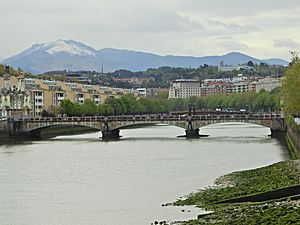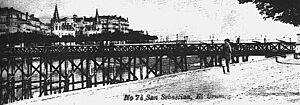María Cristina Bridge facts for kids
The María Cristina Bridge (also called Maria Kristina zubia in Basque and Puente de María Cristina in Spanish) is a famous bridge in the city of San Sebastián, Spain. It crosses the Urumea river in the Basque region. This beautiful bridge connects different parts of the city and is known for its grand design.
Contents
Building the Bridge: A New Connection
In 1893, a simple wooden bridge was built first. This temporary bridge helped people get from the city center to the North Station, a bullfighting arena, and a velodrome (a track for cycling). It made travel much easier for everyone.
Just before the new, permanent bridge opened, the old wooden one was taken down. This made way for the impressive structure we see today.
Grand Opening Day: January 20, 1905
The final María Cristina Bridge was officially opened on January 20, 1905. This day is special in San Sebastián because it's the feast day of Saint Sebastian, the city's patron saint. It was a very exciting event for the city!
The city's mayor invited many important people to the opening. The invitation asked guests to wear formal clothes. The local savings bank helped pay for the bridge. They gave a loan that would be paid back over 100 years without interest.
The bridge was designed by José Eugenio Ribera and Julio Martínez Zapata. Marcelo Sarasola was the engineer, and José de Goicoa was the city's architect.
Amazing Design and Features
The María Cristina Bridge is very special because of its design. It has four huge stone towers, called obelisks, at each end. These towers are 18 meters (about 59 feet) tall! They look like copies of the obelisks on the famous Alexander III bridge in Paris, France. Each tower is topped with beautiful sculptures.
The bridge itself was built using reinforced concrete. This was a new and modern building material for that time. It has three large arches, each 24 meters (about 79 feet) long. The bridge is 20 meters (about 66 feet) wide and 88 meters (about 289 feet) long in total.
A Day of Celebration
The opening of the bridge was a huge party for San Sebastián. Many people gathered in the streets nearby to see the event. The ringing of bells announced the arrival of religious leaders.
The famous Orfeón Donostiarra choir and the Choir of the Municipal Academy of Music of San Sebastián performed. A group of 110 children sang a special song written just for the occasion.
Later that evening, fireworks lit up the sky near the North Station. There was also a traditional event called a "toro de fuego" (fire bull). This is when someone runs with a frame shaped like a bull, covered in fireworks.
At the time, there had been some disagreements in the city about local festivals. So, police officers were present to make sure everything went smoothly and safely during the celebrations.
See also
 In Spanish: Puente de María Cristina para niños
In Spanish: Puente de María Cristina para niños




